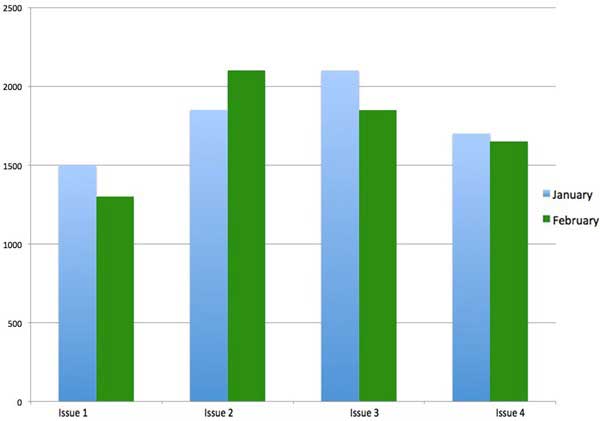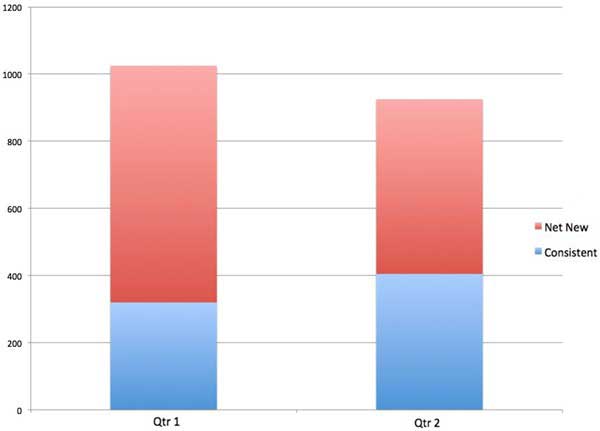I can't tell you how many things—magazine articles, email newsletters, Facebook updates, tweets, blog posts—come across my desk every week that purport to be about "social CRM" (customer relationship management) measurement tools.
Actually, I could.
I could make a pretty little chart and break it down by type of article, and even by source.
And it might look something like this:

I think we could all agree that the value of this chart is questionable, at best. It's pretty, and if we tracked it over time, we might even be able to find some insights. We could use it as an indicator of how much interest there is in this topic. Some might even use it to predict growth in this area of marketing.
But no one would propose we use this method to determine the value of the relationships I have with the topics I'm measuring.
So why are so many brands using tools just like this to measure social media engagement?
The problem, in a nutshell, is this: garbage in, garbage out. But before we can discuss how to get the proper data inputs, we need to explore what social CRM could and should be to an organization.
I was quite surprised and saddened to see a quote from someone at Eloqua implying that social CRM is about support requests (at least that's what the quote seems to imply). "Although social CRM and support are, justifiably, hot topics in the media, calls for support account for only 1% of all tweets," Joe Chernov wrote in a post titled "Your Social Media Followers Are Your Best Customers."
Social CRM is about building and managing relationships of value in a world where brands require a digital and social presence:
- For someone with a promotions background, that means identifying likely candidates for offers and tracking them through to conversion.
- For someone with a lead-generation or B2B background, that means getting candidates to self-identify and passing them into a lead-management system.
- For someone with an advertising or media background, that means paying lots of money for TV ads with some mysterious end result of increasing sales. (OK, that is a bad example.)
- For a digital marketer, it means everything. We can no longer afford to not attach profit and revenue valuations to our efforts.
I will talk more about building social CRM programs in a later article. Here, I want to focus on a key aspect of social CRM: our ability to measure our success at building relationships of value.
Let's go back to that first chart. It's an indicator that could show us increased interest, over time, in the topic we're monitoring. I could run a search in January. Then in February, I could run the search again and compare how many people are promoting these tools vs. January. Rinse and repeat.
We end up with a chart that appears in just about every social media monitoring report:

Here, we see the number of people talking about terms that are of interest to us, month over month. It could be about product mentions. It could be about key issues. That doesn't matter. What really matters is how this data helps us understand the value of the relationships we are building (or not building).
But wait. That's not what this chart shows us. It just shows us how many people are talking about something we are searching for. They could be the same people every period, or there could be 100% churn with no consistency across periods. For all we know, our efforts could simply be driving volume at the cost of relationships.
Someone usually pipes up at this point and shows me how they are tracking sentiment. Great. So we're carefully tracking whether overall group mentality and conversation is trending positive or negative, but we still have no way to measure the relationships. Awesome.
I should point out that the fault for all of this confusion lies partly with the tool providers. We are all starting with measurements that social media monitoring tools just happen to provide. But what if we weren't? What questions would we ask if we were designing this measurement program from the ground up? What knowledge would we want? How would we design the reporting tools to help us build long-term relationships of value to our brand?
Here are just some of the types of key questions we should be asking:
- How many of the people from January are also active in February? What about in March?
- Is there a core group of people driving different conversations?
- What percentage of these people want to engage with our brand?
- Is the group that talks about us more often over time more or less likely to purchase or participate in an activity?
In the charts presented earlier, we're actually throwing away the data we gathered the previous month. So the first question we need to answer is this: What percentage of people from one period is still taking about us in a later period?
We need to start creating and seeing charts like this one:

If you've invested a lot in social or digital media, I hope you have a growing percentage of people talking about you or engaging with you month over month and quarter over quarter. And, if you do, who are these people? Which ones are driving the conversation? How do their sentiments compare with those of the rest? Or, my favorite question: what else are they talking about?
In short, it's also important to look at how influence is being defined. Tools like Klout provide great shortcuts for understanding the activity and reach of individuals online. But what if your influencers don't rate highly in Klout? What if they are everyday people who are so passionate about your brand that they are talking about you every month... and you just don't know who they are?



